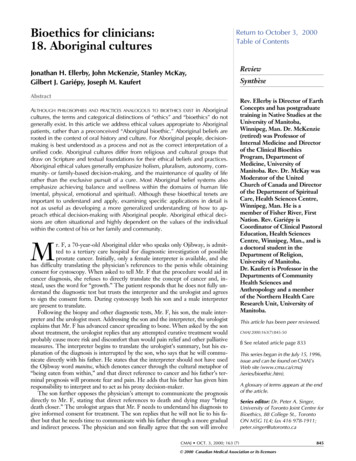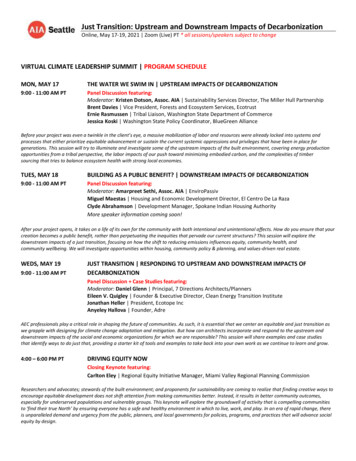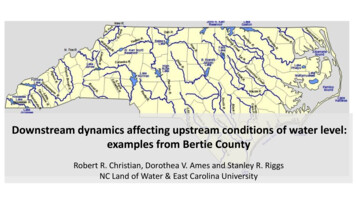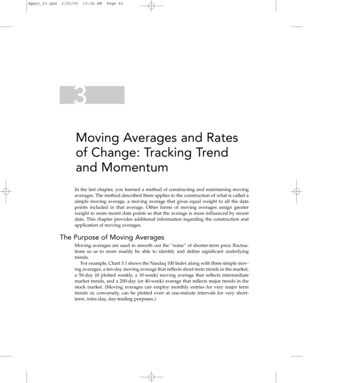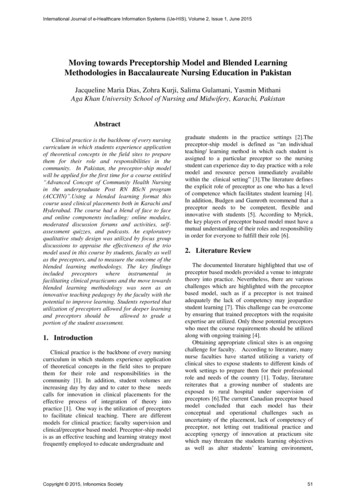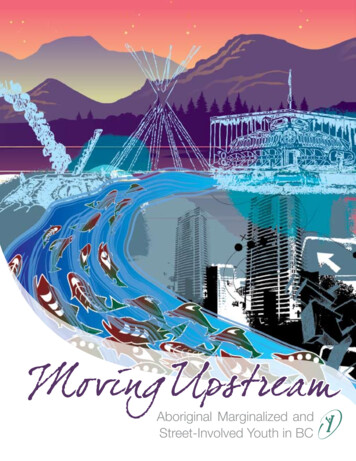
Transcription
Moving Upstream:Aboriginal Marginalized and Street-InvolvedYouth in B.C.Copyright 2008 by The McCreary Centre Society3552 Hastings St.Vancouver, B.C.(604) 291-1996mccreary@mcs.bc.cawww.mcs.bc.caThis report is available as a free downloadable pdf file from the website.1
Project TeamElizabeth SaewycPrincipal Investigator (PI)Research Director, McCreary Centre Society &Associate Professor, University of British ColumbiaAnnie SmithExecutive Director, McCreary Centre SocietyBrittany Dixon-BinghamResearch Assistant, McCreary Centre SocietyGraduate Student, Simon Fraser UniversityDana BrunanskiResearch Assistant, University of British ColumbiaGraduate Student, University of British ColumbiaSarah HuntAboriginal Community Collaboration Coordinator, McCrearyCentre SocietyCover Art by: Tania Willard, Red Willow DesignsAn artist and designer from the Secwepemc (Shuswap)Nation in the Interior of B.C., Tania Willard wrote this aboutthe cover art she created:The illustration for this report was inspired by the salmon run. Thesalmon has been an important part of many B.C. Aboriginal people’sdiet and cosmology. The journey of the salmon is meant to representthe journey we go through in life: the struggles and challenges,swimming upstream to get to home. This innate sense of home isa symbol of our feelings about home and identity as Aboriginalpeople, especially as young people whose journey often includes selfdiscovery, cultural revitalization and the search for our roots. Inthis illustration the salmon swim through an urban centre. Salmonbearing streams criss-crossed the province, but have since been filledin or polluted and no longer are salmon-bearing. But the path isSherry SimonProject Coordinator, Aboriginal Next Steps, McCreary Centrethere; it may be hidden under concrete, but our journey home is stillSocietylost we feel, if we look for it we can find our way home.Melissa NorthcottResearch Assistant, McCreary Centre SocietyPhotos: Youth from Abbotsford, Kamloops, Kelowna, andGraduate Student, Carleton UniversityPrince George who were involved in the research project alsoMorgen Mathesoncontributed photos for the report.there for us to find. No matter what the circumstance, no matter howGraphic DesignerThank you to all the people who made this report possible,Funding for this project was provided by:especially youth and community members from across B.C.The Canadian Institutes for Health Research:Thank you for sharing your experiences and knowledge withInstitute for Population & Public Healthus, and for adding your voices to the project.Institute for Gender & HealthOffice of Research EthicsThe Michael Smith Foundation for Health ResearchThe Child & Youth Health Research Network of B.C.Stephanie Martin, YouthParticipation Coordinator, McCreary Centre Society; SemeeJoo, Research Assistant, University of British ColumbiaFunding for the original 2006 McCreary Centre SocietySchool of Nursing; and Ginger Gosnell-Myers, for theirstudy of marginalized and street-involved youth in B.C.contributions to the process of creating this report.was also provided by the Ministry of Children and FamilyDevelopment.The views expressed herein do not necessarily represent theofficial policy of the funders.Suggested citation: Saewyc E, Bingham B, Brunanski D, Smith A, Hunt S, Northcott M, & the McCreary Centre Society. (2008).Moving Upstream: Aboriginal Marginalized and Street-Involved Youth in B.C. Vancouver, B.C.: McCreary Centre Society.ISBN # 978-1-895438-88-82
Introduction from B.C.’s Representative for Children and Youth, Mary Ellen Turpel-LafondAt a GlanceKey FindingsAbout the SurveyFormation of an Aboriginal Research TeamCommunity DialogueContents of this ReportLimitationsA Note About TermsHistory and Context: Aboriginal PerspectivesAboriginal Youth ProfileShelter and Street InvolvementFamily RelationshipsSchool and WorkGovernment CareHealthPhysical HealthSexual HealthMental and Emotional HealthSubstance UseJuvenile JusticeDiscrimination and ViolenceDiscriminationViolencePhysical AbuseSexual AbuseSexual ExploitationSocial and Community SupportsHelp-seekingAccessing Community ServicesSport and RecreationFilling the GapsLooking to the FutureFinal WordList of ContributorsOther McCreary 394041424445485051545558623
Introduction from BC’s Representative forChildren and Youth, Mary Ellen Turpel-LafondTo understand a person you must take a lookat the world, as best as you can, through theirexperience. In First Nations parlance, we say“walk a mile in my moccasins.” The messageis clear: Learn before you form an opinion—beopen to another person’s experience. Foryouth, keep the focus on them and ensure thesystem responds to them appropriately andrespectfully given their unique rights. But also,listen to what they say. Their voices will tell uswhat they need.Hunger, homelessness, homophobia, physicaland sexual violence and racism. These are notour wishes for the lives of Aboriginal childrenand youth in British Columbia. A walk in theirmoccasins with the McCreary Centre Society,through a closer look at marginalized andstreet-involved Aboriginal youth, tells a grimtale of our service delivery system failing toreach Aboriginal youth and the cracks in ourcivil society which challenge themost vulnerable.4Moving Upstream should be read by everyonein the social serving system in BritishColumbia - health care providers, FirstNations leaders, educators and educationadministrators, justice workers includingpolice, and child welfare and youth supportservice workers. The survey speaks loudlyof the need to improve the system of supportfor Aboriginal youth across British Columbia.They have experienced far too much sufferingand difficulty, often at the hands of adultsin their lives, and because of the absence ofsystems of support. Their resilience dependson our willingness to hear their voices, listento them and meet them where they are, withassistance in a committed andrespectful manner.A strong civil society will present everyopportunity for the most vulnerable to besafe and healthy. A civil society nurtures thelearning spirit. It norms excellence for youngpeople and makes it possible through support.Each of us needs to work to build that systemand the bedrock will be what the McCrearyCentre Society has done here – listening toyouth, engaging, respecting their voice.As B.C.’s Representative for Children andYouth, I thank the youth for participating.They require a strong social support system toovercome the barriers they and many of theirfamilies face. The McCreary Centre Societyhas provided a valuable opportunity to hearthe voices of Aboriginal youth. Let’s makesure the next walk in their moccasins is on abetter path, with improvements and greateropportunities to fulfill their hopesand potential.
Key FindingsIn 2000 the McCreary Centre Societyconducted a health survey of marginalizedand street-involved youth in six communitiesacross British Columbia. The study wasrepeated in nine communities in 2006 andwas completed by 762 youth, 410 of whomidentified as Aboriginal (54%). In thecommunities that participated in both surveysthere was a rise in the numbers of Aboriginalyouth from 36% to 57%.This report takes a closer look at theexperiences of those Aboriginal youth whocompleted the survey and also discusses theresponse to these findings of communitystakeholders in the nine communities thatparticipated. Unless otherwise noted, theinformation in this report includes only those410 youth who identified as Aboriginal.Although the survey was not created witha cultural lens, the community discussionsthat took place to guide this report clearlyemphasized the importance of including sucha lens when considering the research findings,including the legacy of colonization, culturaldisconnection, the diversity of Aboriginalcultures, and the importance of culturallyrelevant interventions. More than half of the youth involvedin the original survey were Aboriginal,which suggests prevention, interventionand other supportive programmingfor street-involved youth must includeapproaches specifically for Aboriginalcommunities and Aboriginal youth. A large number of the youth reportedleaving home before entering their teenyears. 40% of males and 47% of femaleshad first run away at age 12 or younger,and one in three had been kicked out byage 12. This underscores the importanceof early interventions with families. Lesbian, gay, and bisexual youth (LGB)were highly over-represented, especiallyamong female participants. Only 44% offemales identified as 100% heterosexual,compared with 77% of males. 42% of those who participated in thesurvey had been in foster care. 47% had gone hungry because they ortheir parents didn’t have money forfood. Violence was a significant issue formost of the youth. 63% reported havingwitnessed family violence, and almost60% having been physically abused.5
30% of males and 23% of females had beensexually exploited. Youth who reportedphysical or sexual abuse were twice aslikely to be sexually exploited as those whowere not abused. 1 in 3 youth had been pregnant or hadcaused a pregnancy. Substance use was a significant issuefor the majority of teens surveyed, andimportant in community discussions. Youthwere likely to report a family history ofsubstance use, as well as to use drugs oralcohol themselves. Among those youthwho felt they had a problem, nearly half(47%) wanted detox services, outpatientor residential treatment; however, 9% ofyouth said these services were not availablein their community. These numbers wereconsistent with findings for street-involvedyouth in general. 6Aboriginal youth in the survey reportedbeing discriminated against for a numberof reasons, with 1 in 4 reporting racialdiscrimination in the past year. Femaleswere more likely to face discriminationthan males, with 51% of females reportingdiscrimination in the past year comparedto 39% of males. It is important to keep inmind that street-involved and marginalizedAboriginal youth may be discriminatedagainst because of a number of intersectingfactors at any given time.26% of males and 36% of females seriouslyconsidered suicide in the past year. 30%of females and 18% of males had actuallyattempted suicide at least once during thepast year. Youth in the most precarious livingsituations were less likely to be in school,but surprisingly, 41% of youth who livedin squats, abandoned buildings, tents, onthe street, hotels, and in shelters reportedattending school. Despite the challenges they face, mostparticipants were hopeful about theirfuture. When asked to envision their lifefive years from now, 50% expected to havea job, 33% would have their own home,25% expected to have a family and 19%thought they would be in school.Some participants had high educationalaspirations: 26% planned to graduatefrom a post-secondary institution. The community discussions highlightedthe importance of connecting streetinvolved youth with cultural andtraditional teachings in order tostrengthen their relationships to theirhome communities. Young people in all the communities saidtheir communities needed more services;the most common services needed werefor safe housing (61% indicated one of thehousing responses), job training (49%),work experience (38%), as well as schoolprograms (33%), life skills programs (29%)and youth clinics (29%).To read more about the recommendationsfrom youth and from community discussions,see the Final Word section of the report, onpage 57.
About this ReportIn the fall and winter of 2006, McCrearyCentre Society collaborated with a numberof community organizations and youth toconduct a survey of marginalized and streetinvolved youth in nine communities across theprovince. We wanted to hear from youth abouttheir lives and their needs, in order to helpcommunities improve programs and services.One of the unexpected findings of the researchwas that 54% of the youth surveyed acrossB.C. identified as Aboriginal, which is muchhigher than the percent of Aboriginal youth inschool (9.8%; Ministry of Education, 2007).Our community partners and co-researchersfelt it was important to create an additionalreport to focus on the lives of the Aboriginalyouth in the survey, and we agreed. Thisreport is the result of additional discussionswith stakeholders in the nine participatingcommunities, as well as the work of a team ofAboriginal researchers and project advisors.About the SurveyThe McCreary Centre Society’s 2006 surveywas administered to young people involvedin a street lifestyle, including those who werehomeless, panhandling, involved in the sextrade, selling or using drugs, engaging incriminal activities, or who had recently leftthese situations. The survey was a penciland paper questionnaire based on previousMcCreary youth health surveys, withadditional input from an advisory committeeof representatives from youth-servingorganizations (including several Aboriginalorganizations) from nine communitiesacross B.C.In these communities, community researcherteams of youth with experience in streetinvolvement and staff from local agenciessurveyed 762 marginalized and streetinvolved youth between the ages of 12 and 18.The original survey was not designed to speakto the specific needs of Aboriginal youth andcommunities, but was designed to learn fromall groups of street-involved youth abouttheir experiences. We acknowledge that thishas resulted in a lack of culturally-specificresearch data, but we aim here to contextualizethe findings within a more culturally-relevantframework.More information about the survey and themethods are reported in Against the Odds: AProfile of Marginalized and Street-Involved Youthin British Columbia (2007).Communities in the 2006 ce GeorgePrince RupertSurreyVancouverVictoria7
Formation of an AboriginalResearch TeamHistorically, most research about Aboriginalpeople has been done
Lesbian, gay, and bisexual youth (LGB) were highly over-represented, especially among female participants. Only 44% of females identifi ed as 100% heterosexual, compared with 77% of males. 42% of those who participated in the survey had been in foster care. 47% had gone hungry because they or their parents didn’t have money for food.
